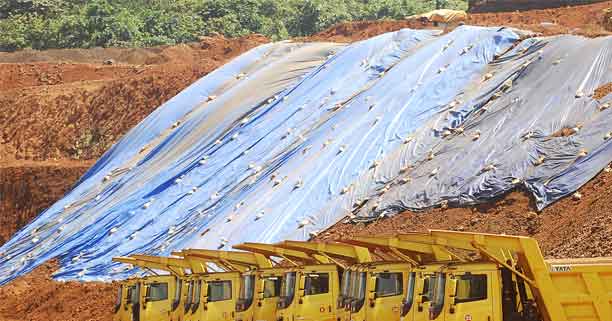After the celebrations, search sighs and groans, more questions are raised than answered
Firecrackers bursted and sweets were distributed after the Supreme Court lifted the ban on iron ore mining in Goa. And yet the stunning decision has raised far more questions than it’s answered.
When will mining, long the state’s largest revenue earner, actually resume? Will new players be allowed into the industry? Or will the same old mining oligarchy continue to run the show? Will the corruption and environmental degradation be controlled this time around? Is the court’s “cap” on total iron ore output the right one?
In lifting the ban, the Supreme Court also declared that all mining leases, barring around a dozen, actually expired in 2007. That means that the vast majority of mines operating between 2007 and the 2012 ban have now been essentially declared illegal. It also means the handful of Goan families who have controlled mining since Portuguese times – the Dempos, Chowgules, Salgaocars, and Timblos among them – have no guarantees they’ll be able to secure the new concessions.
If mining is to restart, leases will have to be allotted afresh. And the traditional mining families aren’t the only ones who will be in the race for fresh leases.
How and when the government begins the process for issuing those leases remains to be seen, with Chief Minister Manohar Parrikar saying he will come up with a “transparent” policy by June.
Parrikar has hinted that he’s not keen on an auction process, since the Supreme Court gave no such specific instruction. But a group of dedicated Goans is watching his every move. Chief among them is renowned environementalist Claude Alvares, who has warned he wouldn’t hesitate to re-approach the Supreme Court, “should the procedures for grant or renewal of leases not be fair or transparent, or in consonance with constitutional requirements.”
Will Goa’s traditional mining families have any advantage in the granting of leases? Perhaps, but the Supreme Court decision looks sure to bring in bigger and more powerful mining players operating in other parts of the country, or even foreign players.
Among the most important aspects of the Supreme Court decision was its annual cap of 20 MMT (million metric tons) of total iron ore production. The argument goes that since a blanket mining ban is no good because it’s bad for the economy, and since a mining free-for-all is no good because of what it does to the environment, surely a happy medium must be in order. Thus was born the idea of placing a cap on total production.
Environmentalists are divided over the cap.
“On what basis has the figure of 20 MMT been arrived at? A dosage has been prescribed without the patient being examined,” Ramesh Gauns, an award winning teacher and staunch anti-mining campaigner, told Goa Streets. He said no mining should be allowed until a comprehensive study on the cumulative effects of mining have been carried out.
But Gauns’ bigger worry is one that he shares with much of civil society and greens across Goa: “Can the state government be trusted to act in the best interest of the state or in the interest of the mining companies?”
And not without reason. Since coming to power, the chief minister has often spoken the language of the mining companies, saying there was no illegal, only irregular mining in the state, questioning the authority of the Supreme Court, terming the intentions of the petitioner, Alvares’s Goa Foundation “malicious” and even saying that illegal mining had cost the government just 5,000 crore (a figure activists consider ridiculously low).
The Justice Shah Commission of Inquiry investigating illegal mining in Goa spoke of illegal mining reaching Rs. 35,000 crore between 2007 and 2012 – and Claude Alvares puts the figure at closer to Rs 65,000 crore, all of which he believes needs to be recovered.
“I do not trust Parrikar to do the right thing,” Alvares told local reporters.
Gauns was no more optimistic.
“The entire machinery is being used to see how loopholes will be found in the laws, in the judgement. It wasn’t as if there weren’t any laws in place when the mining scam first started. The administration will now work out ways to bypass this judgement too,” he said.
Another environmentalist, Rajendra Kerkar however, is happy with the judgement, saying it will “restore the faith of the people in the constitutional principles guaranteed to every individual and the relief offered by the courts.”
The declaration that mining was illegal from 2007 does open the door for proceedings to recover tens of thousands of crores – a prospect that, if achieved, could be a windfall for the state treasury.
In the meanwhile, the State of Goa is already getting the sales proceeds from the disposal of inventories of 15 million tonnes, which are in the midst of an e-auction. This will be worth Rs 4500 crore.
If the mining was illegal, another big question is will anyone be prosecuted for it? The list of those who might have to answer for the illegalities include industry barons and powerful politicians.
BJP legislators representing mining belt areas, Subhash Phaldessai from Sanguem and Pramod Sawant, from Sanquelim, had little to say when questioned on whether anyone would be prosecuted, saying they’re not sure and that it’s “for the police to act.”
Officials at the Directorate of Mines and Geology said the nine mining leases which did not expire in 2007 would be the easiest to restart. Further there are another 20-odd leases which have paid a renewal fee to the government and they, too, will likely be able to restart ahead of the others. In all, it’s expected that around 60 of the previous 90 leases will at some point come into effect.
Sesa Sterlite, the state’s largest mining company, is optimistic.
“The Company is working towards securing the necessary permissions for commencement of operations at the earliest,” a statement from the company read.
Mining companies have remained unusually tightlipped over the judgement, with the Goa Mineral Ore Association issuing a terse statement welcoming the Supreme Court ruling.
In this entire process, perhaps the hardest hit have been the truckers who now find that at least half their trucks are redundant. Interestingly, deep pocketed mining companies have very little liability towards truck and machinery operators, who have had to bear their own investments.
In the midst of it all, falling demand by China and an increase in production by the state’s two top competitors, Brazil and Australia, has put pressure on international prices. Renewed supply from Goa would add to an expected surplus pushing down prices.
Global iron ore prices are currently at $117 a tonne and have fallen more than 13 percent this year.
How long will it take for mining to actually restart? “Your guess is as good as mine,” Alvares says. Don’t expect anything before the monsoons.




